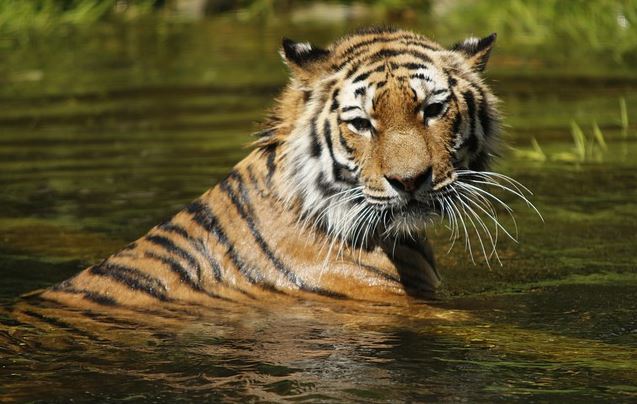The Amur Tiger, also known as the Siberian Tiger, is living and reproducing in China again, according to video footage captured by a World Wildlife Fund (WWF) camera trap in the Wangqing Nature Reserve nearly 20 miles from the Russian border.
In the video recording (at bottom of page) taken late last year, one can see a tigress with her playful cubs, which confirms they were born in China. At that age, they could not have walked 20 miles from the Russian border.
The only previous evidence of Amur Tigers in China have been footprints, which could have come from animals that were born in Russia.

A Siberian tigress (Amur tigress) with her cub at Buffalo Zoo. (Image: Wikipedia)
Division head of the Wangqing Nature Reserve conservation department, Wang Fuyou, said:
“These images show that Wangqing Nature Reserve has now become a breeding site for Amur tigers. Seeing these positive outcomes from our efforts greatly strengthens our confidence that wild Amur tiger populations can be restored.”
Hunting nearly wiped out the Amur Tiger
Amur Tigers were once common across the whole of northern China, as well as the Russian Far East and throughout the Korean peninsula.
Both the Red and White armies in Vladivostok in the early years of the Russian Civil War nearly wiped out the local Amur Tigers. The tigers had already withdrawn from China’s northern and western range when the Manchurian Chinese were driven back across the Amur and the Ussuri in 1935.
The few that did manage to survive (in China) remained in the East Manchurian mountains. They were cut off from the main population by the expansion of the railways.
By the 1940s, the only remaining wild Siberian Tigers were confined to Ussuriland, the far-eastern region around Vladivostok, facing northern Japan. It was on the brink of extinction with only 40 individuals remaining in the wild.
Tiger hunting was legal in the Soviet Union until 1947, when it was officially prohibited and strict anti-poaching controls came into force.

Amur tigers are excellent swimmers. Their prey include salmon, musk deer, goral, red deer, moose, Siberian roe deer, sika deer, wild pig, Asian black bear, rabbits, hares and pikas. (Image: Pixabay)
Decades of conservation work paying off
According to WWF:
“The new footage of the tiger family is the result of decades of conservation work aimed at establishing a breeding Amur tiger population in China. WWF’s Amur Tiger Conservation Plan designated China’s combined Wangqing-Hunchun-Suiyang-Dongning Area as a priority zone for wild tiger conservation in 2010.”
There are several conservation projects in the area, including the re-introduction of tiger prey and maintenance of forest corridors where the animals can roam freely.
WWF receives strong support from the Jilin Provincial Forestry Department for its work in the region.
WWF, which is working with all tiger countries, says it aims to achieve Tx2 by 2022, i.e. to double the number of wild tigers. The next Chinese Year of the Tiger is in 2022.
WWF Video – Tiger Family in Inland China
In this video footage taken by a WWF camera trap, you can see a tiger family – a tigress with two playful juveniles – in Wangqing Nature Reserve.

